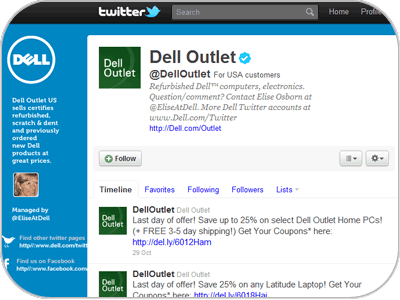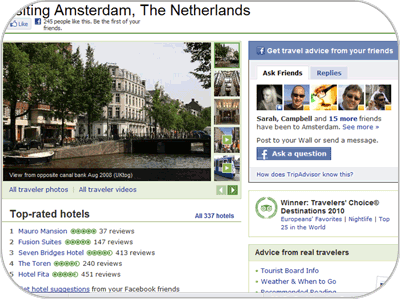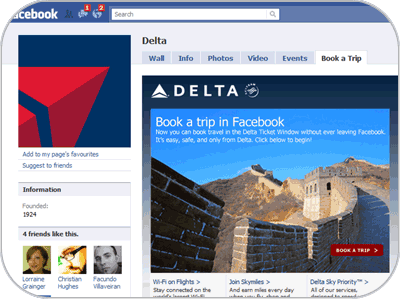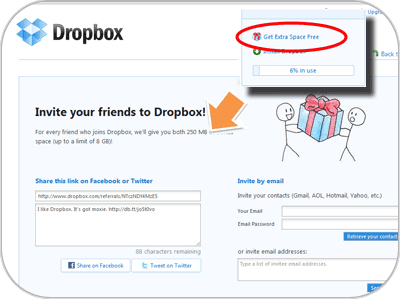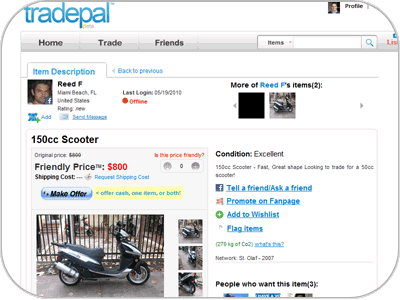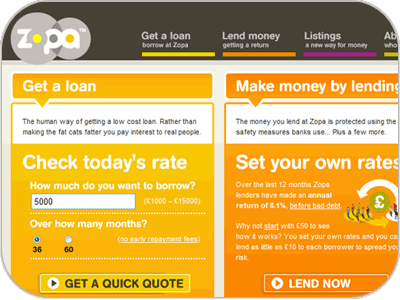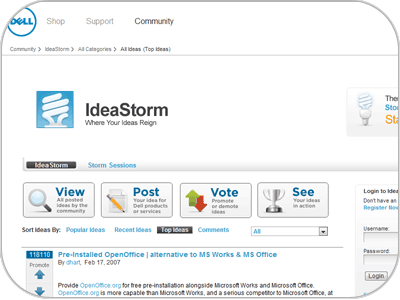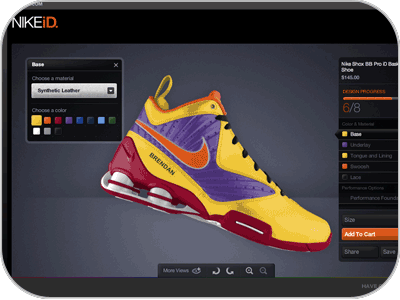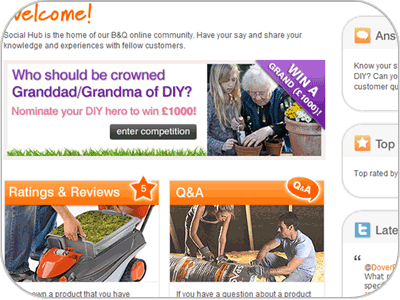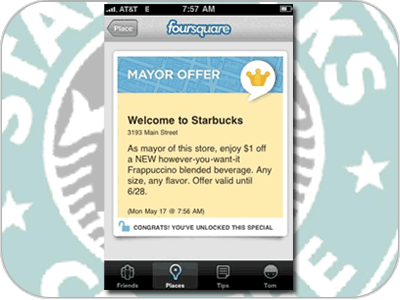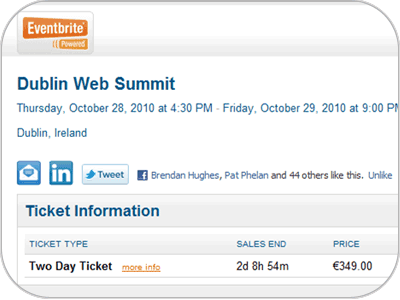Friday 26 November 2010
Blueprint to Making Money TODAY ..... interested?
in the US when people go a little spend crazy!!Here is a quick
tip that I used last year on "Black Friday" to
take advantage of the massive amount of buying taking place in
the US today both online and offline!
1. Go to Amazon.com and sign up as an affiliate
2. Open your twitter account(s)
3. Create a link to an ipad or another hot new product for sale
using your affiliate link
4. Write a tweet like "OMG .... the ipad deals for Black Friday
today are CRAZY "put link here""
5. Add the hashtag (#) #blackfriday to the end of your tweet
6. Your tweet will look like this OMG .... the ipad deals for
Black Friday today are CRAZY "put link here" #blackfriday
7. Tweet and retweet across your twitter accounts
8. Watch the sales roll in :)
The beauty of this is that no matter what you promote with your
link, if people buy ANYTHING on amazon after they used your link,
you get a commission!
Remember Amazon is designed to sell so they do all the work!
Sweet right!?!?
Enjoy
Paul & Mili
Thursday 25 November 2010
Happy Thanksgiving
would like to use the opportunity to thank all of you so much for
your help, support and contribution in the past year
It has been an amazing year of challenges and opportunities and
we feel very blessed to have shared it with you!
I happened to be reading Wayne Dyer this morning and there are
two quotes that I would like to share with you today
"Change your Life by constantly choosing to be in a state of Gratitude"
Even
After
All This Time
The Sun Never Says To The Earth
"You Owe Me"
Look
What Happens
With a Love Like That
It Lights The
Whole
Sky
Have a great day
Paul & Mili
Wednesday 24 November 2010
Siemens release their Social Media Do's & Don'ts
1.DON’T: Assume customers won’t notice your absence in social media channels
DO: Keep current as communication channels evolve
Customer contact channels never stand still...neither should you! A recent Yankee Group (News - Alert) study revealed that 70 percent of consumers want to be able to leverage social media sites to see real-time availability of company experts in area such as billing and technical support. Customers are searching for you online, so be readily available.
Also, being present with new media not only gives you the opportunity to serve customers where they are congregating and communicating, but being early or first in your industry allows you to differentiate yourself on customer service and accessibility.
2.DON’T: Miss out on conversations with your customers
DO: Identify where your customers are communicating on social media, and target relevant corporate or public outlets for monitoring
Take advantage of powerful automated tools that monitor, filter and notify of customer, stakeholder and prospect activity on social networks or community sites. The filtering criteria can be customized based on your objectives and highly tailored to your business needs. The same Yankee Group survey uncovered that 67 percent of employees need more tools to track and manage their social communications for business purposes.
3.DON’T: Cripple your contact center by keeping communications methods silo’ed
DO: Leverage the effectiveness and efficiencies of your contact center via integration
Leverage the skills, resources and processes by integrating key social media outlets with your contact center technologies, tools and processes. As volumes grow, using ad hoc methods or dedicated personnel may be inefficient and ineffective. Better to build in social media tools from the beginning and allow them to become part of how you do business.
4.DON’T: Let employees’ social media usage become a liability for your business
DO: Train employees on the subtleties of effective social media interactions
Social media interaction is somewhat different than e-mail, voice or face to face. Remember, social media conversations are usually in the public domain! Enforce company social media guidelines and keep employees educated.
Often it can be wise and effective to move and morph a social media dialogue into a richer and/or more private media e.g. voice, e-mail and chat. Communication that begins in a social networking forum should be moved to phone or e-mail for ongoing conversations.
Tuesday 23 November 2010
Social media replaces phone on the road
Waiting for word from a loved one on the road? Don’t sit by the phone. These days, chances are they’ll keep in touch through social media, according to a survey released yesterday by Sheraton Hotels & Resorts.
More than 60% of respondents in the global social media study use social media to stay in touch with family and friends while traveling; more than a third (36%) say they’d rather log on than make a call to share good news.
Overall, survey respondents ranked social media somewhere near air and water as a must-have in their lives. Four-fifths of respondents said they access social networking sites throughout the day, while 39% said they “could not live without” social media sites. One-third of respondents said they log in multiple times each hour. Habits barely shift on the road. One fifth of respondents say that they check social networking sites multiple times throughout the day while traveling.
The global study was conducted by Studylogic LLC, which surveyed 4,204 people via phone in the USA, UK and China. Sheraton recently completed the roll-out of its signature offering “Link@Sheraton experienced with Microsoft,” a technology-driven social hub that keeps travelers connected 24/7 at nearly 400 hotels around the world.
Social Networking Blurs Lines between Business, Pleasure
Careful what you post. Before meeting a new business contact, more than half of those surveyed check out their new contact’s social networking profiles (54%). Nearly 60% say they have not hired a candidate based on a negative impression from a social-media profile. More than half (54%) of respondents say they know someone who has been fired for something said or posted online.
Regardless of pitfalls, social networking’s popularity as a networking tool continues to grow. More than half of all respondents (56%) agreed about the importance of doing business with people active in social media channels; 55% use online social networking to meet new business contacts and maintain current ones.
And many use social media to mix business and pleasure – literally. More than half of those surveyed have arranged a romantic interlude on the road using social networks, with men more likely to do so (45%) than women (40%).
Fact or Fiction?
Don’t always believe what you read. Nearly 70% of respondents say they aren’t honest on social networking sites; 27% of those fib “a little,” 21% flat-out “lie,” and 20% admit that their postings are total fabrications. Women are more inclined to tell little white lies online; men were more likely to be 100% honest (46%) versus their female counterparts (18%).
Who Are People Visiting While on the Road?
More than 50% of all Sheraton guests use the Link@Sheraton during their stay. Facebook is the most visited site at the Link@Sheraton, with 75% of Link users logging in during their stay. More than 60% of those surveyed (62%) find that social media makes it easier for them to meet people while traveling for work.
Social Media as a Travel Planning Tool: 64% say yes
64% said they use social media to make their travel plans and within the 25-34 year old participant group, the number is even higher; 76% look to popular social media sites to plan their next getaway.
”Along with the bigger shift toward social media from other forms of communication, what the survey drove home for us was that an experience like Link@Sheraton isn’t a luxury for guests, but a necessity,” said Hoyt Harper, SVP and Global Brand Leader for Sheraton Hotels & Resorts. “They expect total connectivity.”
Designed as a social environment, The Link@Sheraton invites guests to interact with each other while they check their email, research local attractions and even print boarding passes using free Wi-Fi and Internet-enabled computer stations. It also features a Link@Sheraton Café, televisions and daily newspapers.
Monday 22 November 2010
Time to take Twitter to the next level!
In short: Twitter is launching a powerful tool that will make marketers salivate. What's more, it's being reported that the product may start at a surprising price: Free.
Is Twitter simply throwing money away?
Tracking social media is big business, and the news that Twitter is set to enter the ring with a free product of its own may strike fear in the hearts of market leaders. "Social media monitoring" services charge anything from tens of dollars to tens of thousands of dollars per month to provide brands with insights about their social marketing efforts.
The popular product Radian6, for instance, has prices starting at $600 per month. What's more, brands large and small willingly pay these rates, keen to understand what their customers are saying about them on social media sites -- and perhaps influence those conversations.
But few businesses are aware such services exist. Twitter would have the advantage of putting its analytics product directly in front of its 175 million users. With prices ranging from $10 per month for the individual user to thousands of dollars per month for corporate customers, such a service would easily be worth hundreds of millions of dollars per year.
So why wouldn't Twitter jump at this opportunity?
One obvious reason: Businesses are more likely to stick with Twitter if they're able to measure and improve upon the effectiveness of their marketing efforts. To continually update a Twitter feed requires significant effort, and without any evidence that the activity is improving the bottom line, it's hard to make the business case for maintaining a Twitter account.
With detailed statistics made available to every user, however, the story is very different -- a free analytics product would improve the company's poor user retention rates.
There's another reason to make a social analytics product freely available: Facebook already does. Facebook Insights, which provides in-depth data to Facebook page owners, allows news organizations, brands and small businesses to optimize their Facebook usage to achieve their business goals.
Given the choice between paying for Twitter stats or using Facebook Insights for free, perhaps some businesses would choose Facebook as their social platform of choice.
Customer service concerns may also have swayed Twitter's thinking. When using a free product, customers have low expectations about the level of personal service they expect to receive. But once those same customers are paying hundreds or even thousands of dollars for a product, there's a need for a much larger customer service team.
Or perhaps Twitter just wants to get people hooked. While the company is rumored to be launching the product as a free service, there's no reason Twitter couldn't charge for extra features in the future. Offering a free service to get customers in the door (the so-called "freemium" model) could help the company attract more paying customers at a later date.
So will a free analytics product mean Twitter is throwing away hundreds of millions of dollars per year? Not necessarily: In the long term, a starting price of free may make better business sense for the social media giant.
Thursday 18 November 2010
50 Greatest Twitter Tips & Twitter Secrets
I’ve been tweeting for quite some time now, mainly for personal learning, making new friends, and observing what communities are doing. Following are 50 greatest Twitter tips and Twitter secrets to move you towards a successful experience on Twitter.
1.Pick a memorable username.
2.One tweet one story.
3.Try to follow back when people following you, you’ll get credits for your kind action.
4.No puns for optimized headline.
5.Focus on keywords for optimized headline.
6.Don’t consolidate stories.
7.Link directly to the story.
8.No subheads.
9.Don’t try to fill up 140 characters, keep it short to your point.
10.The highest form of compliment on Twitter is the retweet. Share the love, it’s the gift that keeps on giving.
11.Spend some time making a custom background.
12.Don’t make your background look like some sort of advertisement, it turns people off.
13.Speak your mind, be personal and be transparent!
14.Tweet with photo with TwitPic.
15.Be interesting, boring story turns people off.
16.Be informative, now is the time to use Twitter to tell people about your business goals, your professional interests, to spread knowledge and offer customer support.
17.Be interactive.
18.Be considerate, people will feel it.
19.Find a balance, there is no exact number of how many tweets per day.
20.Be a observer, observer what communities are doing.
21.Learn from Twitter user who has most followers.
22.Upload a photo of yourself and show it in your Twitter profile, people love to know who they are chatting with.
23.Try to tweet regularly so that people know you have an active presence.
24.Try to not use Twitter as your own personal “this is what I’m doing” list.
25.Try to add value to the conversation by sharing links.
26.Mix some personal information so that people know you’re a human being and not just an online merchant pushing links.
27.Thank people when they follow you on Twitter with a direct message.
28.Start conversation with the “@” command, don’t just wait for people to talk to you.
29.Ask questions. Twitter is great for getting opinions.
30.Make sure to respond to people that ‘@’ or direct message you to show your respect.
31.Make noise beyond the Twittosphere, this is only way to build a following is for people to know you’re there.
32.Don’t worry about how many Twitter followers you have, if you become an active participant you will see your followers increase.
33.Don’t spam anyone with anything.
34.Promote your Twitter name in your email signature, business cards, websites, blogs. Don’t be afraid to mention Twitter offline either.
35.If you see that people are talking about you (good or bad) on Twitter search, then join in the conversation!
36.Don’t stalk or harass people on Twitter, if someone ignores you, just let it go. The same goes for you, if people are stalking or harassing you, you can block them on twitter.
37.Go mobile, there’re tons of Twitter apps for the iPhone and Blackberry.
38.Try to keep your Twitter “following/follower” ratio balanced.
39.Fill up your information in Twitter profile, people like to know who you are.
40.Link to a website that’s relevant, preferably your blog or Facebook page.
41.Be patient you won’t build relationships or feel the community spirit over night.
42.Get a good desktop client with TweetDeck.
43.Track your results and statistics with TwitterBurner.
44.Make objectives about what you want to achieve by using Twitter, and stick to them.
45.You don’t have to read every tweet.
46.When promoting a blog post, ask a question or explain what’s coming next, instead of just dumping a link.
47.Learn quickly to use the URL shortening tools like TinyURL and all the variants. It helps tidy up your tweets.
48.If someone says you’re using Twitter wrong, forget it. It’s an opt out society. They can unfollow if they don’t like how you use it.
49.Talk to people about their interests.
50.Enjoy and have fun with your Twitter conversation, don’t make it too serious!
Tuesday 16 November 2010
Facebook new Messages: Everything you need to know
The short answer is that it’s like the old or current version of Facebook Messages only one step further in its evoutionary history. At the moment, your Message centre is pretty much a list of any new messages that come in, in chronological order, in a psuedo e-mail inbox style. You compose a message to someone, they receive it and, if you’re lucky, they reply. You might find out about it through e-mail notification but that’s about as complicated as it gets.
The next generation of this facet of the social network takes things quite a few steps on. The first thing to note is that you can now send and receive messages as SMS on your mobile phone as well. On top of that, new Messages will also incorporate your instant Facebook Chat IMs too whether ot not you were online to receive them live. Finally, you’ll also be offered an @facebook.com e-mail address and the new Messages center is where these mails can be sent and received from. Confused? No problem. Let’s get granular.
How does it work
The idea behind the whole project is to make it become irrelevant what device and via which medium people contact each other and it does this by putting all the communications in one place which is the Facebook new Messages centre. Within new Messages, there will be two main areas.
Social Inbox
The Social Inbox is the bigger and more interesting section where you can send and receive communications between yourself, friends and friends of friends. Facebook has more or less ignored the idea of subject headings in messages and will instead list the Social Inbox by contact. Click on the contact and it will expand to show an entire threaded conversation between you and them from the year dot until the present day. This will include all the Facebook Chats as well. It will also include e-mail and SMS communications between the two of you but only those sent to your @facebook.com address and texted from your phone in a special way. More on that in a minute.
You’ll be able to search your Social Inbox as you would your normal e-mail service, i.e. by contact or the content of the messages, and add attachments of all sorts of shapes and sizes at will. You’ll also be at liberty to add people into converstations and remove yourself from group chats that you’ve had enough of. Just like e-mail, you can forward and reply in the normal way but perhaps one of the more interesting twists is the way the Social Inbox will filter your messages - those at the top will be from people closer to you and the group talks will not appear so high up.
Other subfolder
While your Social Inbox is where messages from friends and friends of friends turn up, anything sent by other individuals, faceless corporations and/or spammers, will turn up in the Other subfolder instead by virtue, of course, that they are not in your social network. The idea is that you don’t have to get your bank statements mixed in with your fun stuff. What’s more, it also keeps the riff raff at bay. Should you get social messages or e-mails sent in that aren’t from friends or friends of friends, you can always tick a box next to them in the Other subfolder to switch them forever more to your Social Inbox instead. By the same token, you can demote contacts from certain friends or friends of friends to Other or even block them entirely. That way, the parameters of who gets in and who doesn't remain tight but under your control.
So how does the e-mail and SMS work then?
This is the first time that you’ll be able to send and receive Facebook communications across the Facebook/rest of the world barrier in quite the same way but the upshot is that it will be more or less completely possible to live your entire e-mail and messaging life through the social network.
@facebook.com e-mail
Everyone will have access to a free @facebook.com e-mail address if they so wish to use it. You give it out as your normal e-mail address and anyone who sends e-mails to it will either end up in your Social Inbox or Others subfolder depending upon whether or not they appear in your social circle. You can of course adjust this as it goes but the result is that you get an in-built, if slightly heavy, spam filter. E-mails will appear in your threaded histories under each contact’s name and will integrate just as seamlessly as all the other media. Effectively, you won’t need to know whether it was sent by e-mail or not. Mails will just appear in you threaded histories. When you reply to external e-mail addresses, the formating will appear exactly as it should do when it arrives in Gmail or Hotmail or wherever your recipient chooses to read it.
As for claiming your free @facebook.com e-mail address, the bad new is that it has to be the same as whatever your Facebook public user name is - i.e whatever is written in the URL address bar of your browser after Facebook.com/ when looking at your profile pafe. So, if some bugger has already claimed your name, you’re stuck with Joe.Bloggs173 or whatever it is you got lumbered with. If you haven’t already claimed a public user name, you can do so here. Your actual name whole and pure is unlikely to be available, so please don’t get your hopes up.
SMS
While the rest of the communications methods are relatively smooth, text is perhaps the one that’s not going to work so well. The reason is that you need to preface every text you send with “msg john smith” - if you’re trying to get hold of your buddy John Smith - and rather than send to Mr Smith’s phone number, you text the message to 32665 instead which is the alpha-numeric for FBOOK. Of course, what will happen if you have two friends called John Smith is currently a mystery.
By the same token, you can “Send To Phone” from your new Messages Social Inbox to fling messages straight out to your buddies’ mobiles. All of this can be yours as soon as you activate text messaging from Facebook.
How does this affect my privacy?
As ever with Facebook, the watchword is privacy and changes often cause interesting repercussions in this department. The good news here is that much of it is still largely in your control when you head into the Privacy Settings.
Who can send me a message?
As is currently the case, anyone on Facebook can send you a message whether or not they’re a friend of yours and, in the same way, once you have an @facebook.com e-mail people from outside the site will be able to e-mail you on it regardless of whether or not you know them. The difference, of course, is that all unknown senders will end up in your Other subfolder and not your main Social Inbox. If that isn’t security enough for you, you can change your Who Can Message Me options in the Privacy Settings to keep it to your social circle only.
Will my @facebook.com e-mail address be listed?
Your e-mail address will not appear on your profile unless you want it to. The only issue is that because your e-mail address will match your public user name, people will be able to tell what it is. Whether this is going to cause enormous amounts or spamming into your Other subfolder or not will be a problem that Facebook has to deal with.
Will applications be able to message me?
The short and rather nasty answer is yes. Yes, they will but only applications that you have given permission to do so. Essentially, any app that you attach to your Facebook profile will probably insert the rights to do that. Facebook hasn’t stated which area of your inbox these messages will appear in by default but there should be no problem in blocking or relegating them into the Others subfolder.
Can I delete individual messages from my threaded histories?
At the moment, that’s not possible. You can delete entire conversations but not individual messages.
Who holds the rights to the content of my messages?
Facebook has said nothing specific about this in this announcement, so, presumably it would be the same terms of service that currently apply. As it stands intellectual property that you post on Facebook can be used by the company royalty-free for the time that it exists on the site subject to certain other conditions. So, coupled with the fact that you can’t delete individual messages, it might make some people feel like watching what they say. However, this wouldn’t be the only mail service to hold such rights.
Do privacy settings work the same way for children?
No. Essentially, the Everyone setting doesn’t work in the same way. It is not possible for minors to receive messages from everyone. Instead it will be limited to friends and friends of friends only. Any other messages will be bounced completely and will not even turn up in the Other subfolder.
When can I get Facebook new Messages?
Facebook new Messages is rolling out from now and instructions on the upgrade will turn up as it arrives for your account. If you want to make sure that it comes to you as quickly as possible, then you can request an invitation here.
Social networking to replace email by 2014
Increasing business use of tools such as Twitter and Facebook has resulted in more demand for such systems, says the firm, which predicts that 20 per cent of organisations will use them as their key communication medium by 2014.
Greater security, the availability of the so-called “white-labelled” social networks and more tolerance from organisations allowing use of personal accounts at work are among the factors influencing the business uptake of such tools, says the study.
"The rigid distinction between email and social networks will erode as both become more developed. Email will take on many social attributes, such as contact brokering, while social networks will develop richer email capabilities, " said Matt Cain, research vice president at Gartner.
"While email is already almost fully penetrated in the corporate space, we expect to see steep growth rates for sales of premises and cloud-based social networking services," he said.
The analyst also predicts that in the next couple of years more than half of global businesses will be engaged in some sort of microblogging, with more control and security features, though standalone enterprise use of Twitter-like tools will have less than five per cent penetration.
And only 25 per cent of businesses will routinely use social network analysis to improve performance and productivity through 2015, according to research.
The study adds that more than 70 per cent of IT-led social media projects will fail as technology departments tend to provide an IT solution rather than a social solution that targets specific business value. Gartner says that businesses will need to develop better skills to be able to develop adequate social media solutions.
Gartner also predicts more activity around the development of mobile-based collaborative tools over the next few years.
"As more organisations consider replacing desk phones with mobile phones, they may wish to anchor their collaboration tools also on the mobile phone," said Ken Dulaney, vice president and distinguished analyst at Gartner.
Wednesday 10 November 2010
"Cute" New Twitter Background
recently
It shows the images of the friends you interact with most on
The downside is that you cant put your links to werbsites on it
but I think some of you will like it as "change" and maybe get a
bit of a buzz going!
The site is available here:
http://www.twilk.com
Enjoy!
Tuesday 9 November 2010
More Time Spent on Social Media than Email Worldwide
As the social media trend becomes a normal part of life for internet users the world over, it’s also becoming the most time-intensive activity on the web.
The TNS “Digital Life” survey of internet users around the world found in September 2010 that on average, surfers spent 4.6 hours a week on social sites, compared with 4.4 hours on email, the most common internet activity.

The TNS survey confirmed that not only is email the online activity with the highest overall penetration, but users also are still significantly more likely to send and receive email messages on a daily basis than they are to do any other activity. Nearly three-fourths of respondents checked their email every day, compared with less than half who headed to social sites with the same frequency.
The difference in penetration was less pronounced when users were asked about whether they “ever” participated in an activity, with 98% using email and 86% social, according to TNS.
The 2010 edition of UM’s (formerly Universal McCann) “Social Media Tracker” reported not on usage, but on social profile maintenance. Growth in the US and worldwide has continued, with more than 61% of frequent internet users globally having a profile on a social network.

And it’s little wonder they spend so much of their time on social sites. In addition to a wealth of social games and opportunities to share and generate content, social networks remain at heart a communications tool. US internet users told UM in 2010 they stay in contact with 53 people on average through social media, up from 31.2 last year. Worldwide the trend was similar: Users now keep in touch with 52 friends through social, compared with 38.8 in 2009.
Using Social Media for the Success of Small and Medium Businesses
Word-of-mouth has been transmuted to real-time tweets. TV reportage has been elevated to live Web streams and on-demand videos. Generally pandering advertisements have been turned into messages especially targeted to specific members of the brand’s client base.
All these have set the stage for newer practices and technologies, bringing in much brand and product-driven successes than traditional marketing tactics could ever hope to achieve. True enough, social media has proven to be a stable marketing platform, so if your company has yet to jump onboard the dynamic phenomenon that is social media marketing, you are missing out on a lot of its great benefits.
Follow the Market
According to a recent study titled “What Do Americans Do Online,” social media has risen as the number one American pastime, beating all other online activities. In fact, the Internet Advertising Bureau agrees, even claiming that “If you’re not on a social networking site, you’re not on the Internet.”
Indeed, a massive social migration is taking place and this shouldn’t come as a surprise with celebrities like Oprah Winfrey and Ashton Kutcher driving social networking sites to massive popularity. As such, social media is where the consumers are, and that is where you should set your online marketing focus on.
Ramp up Your Presence
Unless you’re carrying a pretty popular brand, it may not be easy to find you online. So take the extra step by introducing your company and your products to social media by setting up a blog and then creating profiles on Facebook and Twitter, among others. That way, people who like your products can easily find and connect with you online—and you can even pull in untapped markets through their own contacts. These can also serve as effective search engine optimization tools to drive significant traffic to your Web site and help boost your client base.
If you have a physical store, you can also invite your customers to visit, shop and sample your products. To do this, you can have your location listed on geolocation services like Facebook Places, Yelp, Google Places and both Foursquare and Gowalla. These sites will allow you to include contact details, embed maps, photos and would allow subscribers to rate and review their visit; thus increases mentions online.
Better News Distribution
Naturally, as the number of followers grows on your social profiles, you can offer your demographic different ways to receive news updates about your products or any promotion you may have. With its easy accessibility and scalable publishing capabilities, social media offers many great distribution platforms like blogs, live chat rooms, multimedia streams and social networking status updates.
Most notable of these are Facebook’s News Feed and Twitter’s stream. Because they deliver your message in real-time, you provide your followers with the freshest updates as they come, and they can react immediately—by taking part, asking questions or by spreading your message to whoever they think would be interested in their own circles. These services would also let you embed relevant photos, videos and links to give better context to your message.
Improve Social Engagements
Traditional marketing tactics would dictate that we appeal to a majority of people within our demographic. Social media marketing, on the other hand, lets you target factions of any given group, or even specific individuals. By responding to comments on your Facebook’s Wall posts or on your blog’s entries, you can address the general needs of your audience and directly engage with individuals. And this can reflect positively on your brand, showing that you’re there to listen and can also serve as an extension of the customer service hotline.
While these will keep your followers informed, you can up the value your presence offers by also showing your own personality and share other relevant content online you think others will find interesting and useful.
Enhance Your Reputation
As with the nature of social media, everyone online is given a voice. And with it, they freely express their opinions about anything, whether they are singing their praises about a company or harshly criticizing it for its bad service. And this is one unavoidable fact that happens to all brands—whether you’re a top brass institution in your industry with a global presence, or a local cottage industry with a small but loyal customer base. In this regard, social media is just the tool you’ll need as you manage your reputation online.
You can level the playing field using its many messaging platforms, addressing concerns, clarifying issues and thanking commendations as they come. You can publish a response to a rising concern on your blog, link to it from Twitter or Facebook and maybe produce a video to assure your customers of your stance and the series of actions you will take to resolve the issue.
Tuesday 2 November 2010
Social Media Commerce
Many businesses have been ‘exploring’ the opportunities of social media over the past number of years. However, the time has now come for companies to think about realising a direct sales return from social media.
A Nielsen report last year highlighted that 90% of consumers trust the opinions of people they know. 70% trust anonymous ratings and reviews posted online. Compare this with just 33% who trust online banner ads. Social commerce is about leveraging word of mouth referrals to support the sales process; harnessing the power of social and participatory technologies to drive conversions.
Many brands have been shy about asking for the sale when engaging with social media. As Jay Dunn points out in his article on the topic of social selling; it is time to get over this. It’s not all about the conversation. Consumers follow brands on social media platforms in the expectation that they will be sold to.
There has been an etiquette on social media that says we shouldn’t do the hard sell. Sure, but let’s be honest about it; brands only engage in social media in anticipation that it will deliver on the bottom line… eventually. Here are some examples of brands using social applications in direct support of e-commerce activities;
1. Use Twitter for Sales Promotion – Dell:
Dell makes millions through their ‘outlet store’ on Twitter where they inform customers about offers on refurbished computers and electronics. They currently have 1.5 million followers. There are no follow backs or conversations here, just simple and effective sales promotion.
2. Embed Facebook within the Sales Funnel – TripAdvisor:
TripAdvisor has been doing social commerce forever with those ratings and reviews we all rely on. Given some of the trust issues with anonymous (and sometimes planted) contributions they have recently developed a deep integration with Facebook. You can now immediately see which of your friends have been to a particular location and ask them questions directly through TripAdvisor.
3. F-Commerce – Delta Airlines:
Earlier this year Delta Airlines embedded their booking engine into their Facebook page. For increasing numbers of their customers, Facebook is the effective gateway to the web. Why make them go somewhere else to book their flights, when they can do it here in the company of friends? Check out the 1800 Flowers and Old Spice f-commerce offerings also.
4. Facilitate Social Shopping – Mattel:
It’s not all about Facebook and Twitter of course. When Mattel, the giant US toy store relaunched its website in time for Christmas last year they were aware of the power of social shopping. They launched Shop Together which enabled people in different locations to see what each other see (co-browse) and to talk about different products using an onscreen chat window. They set out to make shopping social and fun. Getting the kids to tell grandpa and grandma what toys they wanted for Christmas also had a big impact on the bottom line.
5. Incentivise Social Referral – Dropbox:
Social commerce hinges on recognising the power of social referral and finding ways to incentivise that. Dropbox, an online file synchronisation service, has a clever way of driving social referrals through their currency – storage. When you join Dropbox you get 2GB of free storage. You can pay for extra storage OR can get it through a clever link entitled ‘Get Extra Space Free’. Click on this link and you are brought to a screen that encourages you to invite more people to join Dropbox. For each friend that joins you receive 250mb of free storage and your friend gets 250MB free. Everyone is a winner; you, your friend and Dropbox who gets a new user.
6. Group Purchasing – Groupon:
New business models are rapidly emerging. Groupon is a leader in the social commerce phenomenon known as group purchasing. They offer a deal a day which is a significant discount on a product or service. The deal only becomes active when enough people sign up – encouraging people who sign up early to share with friends. LivingSocial, another group purchasing platform, gives you your deal for free if you can get three friends to also purchase it. Twongo, yet another, continually reduces the prices when more people sign up for a particular deal. In Ireland check out BoardsDeals, GruUpy and CityDeal.ie (owned by Groupon). Groupon raised $200m in funding over the past 12 months, so watch out for many more group purchasing sites in 2011.
7. Trading with Friends – TradePal:
Tradepal is a new service that is a bit like eBay, but instead of trading with merchants you don’t know, you can trade with people in your social network. Overcome any trust issues you may have by buying from people you have a connection with. Weedle, which I was involved with earlier this year, is similar to TradePal but is focused on procuring services from people in your social or professional networks or based on recommendations from people you have a connection with. Afterall, we prefer to do business with people we know.
8. Peer-t0-Peer Financial Transactions – Zopa:
Zopa is a social site that facilitates peer-to-peer lending – get a better deposit rate than you would in the bank or get a better loan rate by dealing directly with other individuals. Zopa acts as the honest broker and takes a small commission. Currency Fair is similar to Zopa but facilitates peer-to-peer currency exchange. If you have dollars you want exchange for euros, for example, and someone else is looking for those dollars, you can do a deal on an exchange rate with each other that will beat what the banks give either of you. Currency Fair was launched in April this year and is based here in Dublin.
9. Co-Create – Dell
Another opportunity available through social commerce is to encourage greater participation in product development. Brands like Dell and Starbucks are creating deeper levels of customer engagement with their products by encouraging and centralising feedback on product design and development. Through IDEASTORM they encourage users to outline improvements they would like to see. Others can then vote on the improvements. In 2007, Dell started selling three computer systems with Ubuntu 7.04 (a Linux operating system) pre-installed – after 100,000 customers requested it.
10. Create and Share – NikeID
Nike takes co-creation to the ultimate level by enabling you to create your own unique designs for your sports gear. You can even design your whole team’s kit. Create a design; share it with friends to see what they think. Buy and wear it to create massive OFFLINE talkability and social referral. Nike is empowering customers to create trends themselves. In addition, Nike can very quickly identify new emerging consumer-led trends. Unfortunately, yellow and purple trainers with “BRENDAN” emblazoned across them will probably not be next season’s big thing ![]()
11. Build a Virtual Community Around the Sales Funnel – B&Q:
B&Q, the third largest DIY store in the world, has recently launched a ‘Social Hub‘ which enables customers to add product ratings and reviews, ask and answer each others’ questions about products, share stories and experiences with the products and join an exclusive online community passionate about DIY. By building an online community B&Q intends to help “motivate and give confidence” to DIY enthusiasts, thus supporting their purchase decisions.
12. Facilitate Offline Communities – Meetup
New tools enable and encourage online communities to meet offline. Meetup is one such service that facilitates self-forming real world gatherings. Here in Dublin, Oddbins facilitate free wine tasting in their shops by using services such as Meetup. People on bulletin boards and discussion forums have been doing this for years. Now brands have a way to facilitate like-minded individuals or fans to gather at their outlets.
13. Driving Offline Sales – Starbucks
Not all products can be purchased online. Starbucks integrate with location-based social networks such as Foursquare to reward customers who ‘check-in’ or visit their coffee shops regularly. Any customer who achieves the social status of ‘Mayor’ of a Starbucks outlet is automatically entitled to discounts on products. Watch this space as new services emerge combining location technology with rewards and group discounts. Check out Irish company GeoDealio and keep an eye on Facebook who look set to launch a new service that will be a hybrid of Foursquare and Groupon.
14. Delivering a Return – EventBrite
Of course the big question everyone has is “Does social commerce deliver?”. Online event booking service, EventBrite recently released some data that showed the average value to them of each type of social share:
Facebook – $2.52
Email (Share) = $2.34
LinkedIn = $0.90
Twitter = $0.43
Each time someone shares an event via Facebook, EventBrite earn an additional $2.52 in revenue. Email comes in a close second, with LinkedIn and Twitter delivering much smaller returns. Clearly there is a return and what’s more you can measure it.
GETTING STARTED
If none of the above has inspired you on how you can start doing social commerce, think about these three things:
- What can I give people to share that they will want to share and someone else will want to receive? Is it useful, entertaining or of value?
- What is my currency? What can I create on my website/platform that is unique to me which I can use to incentivise social referral? Is it social standing or something intimately embedded in my product?
- Am I making it easy for my customers to share? Am I integrating properly with the appropriate applications so that it is very simple for customers to share?



